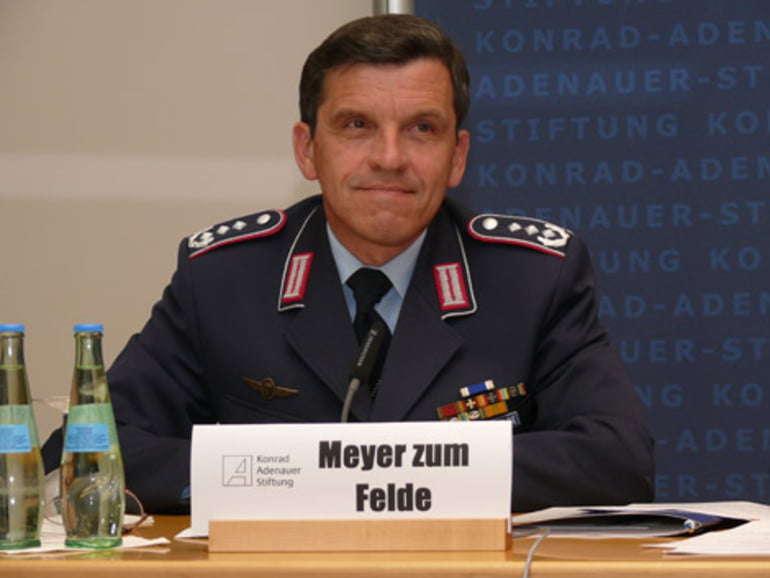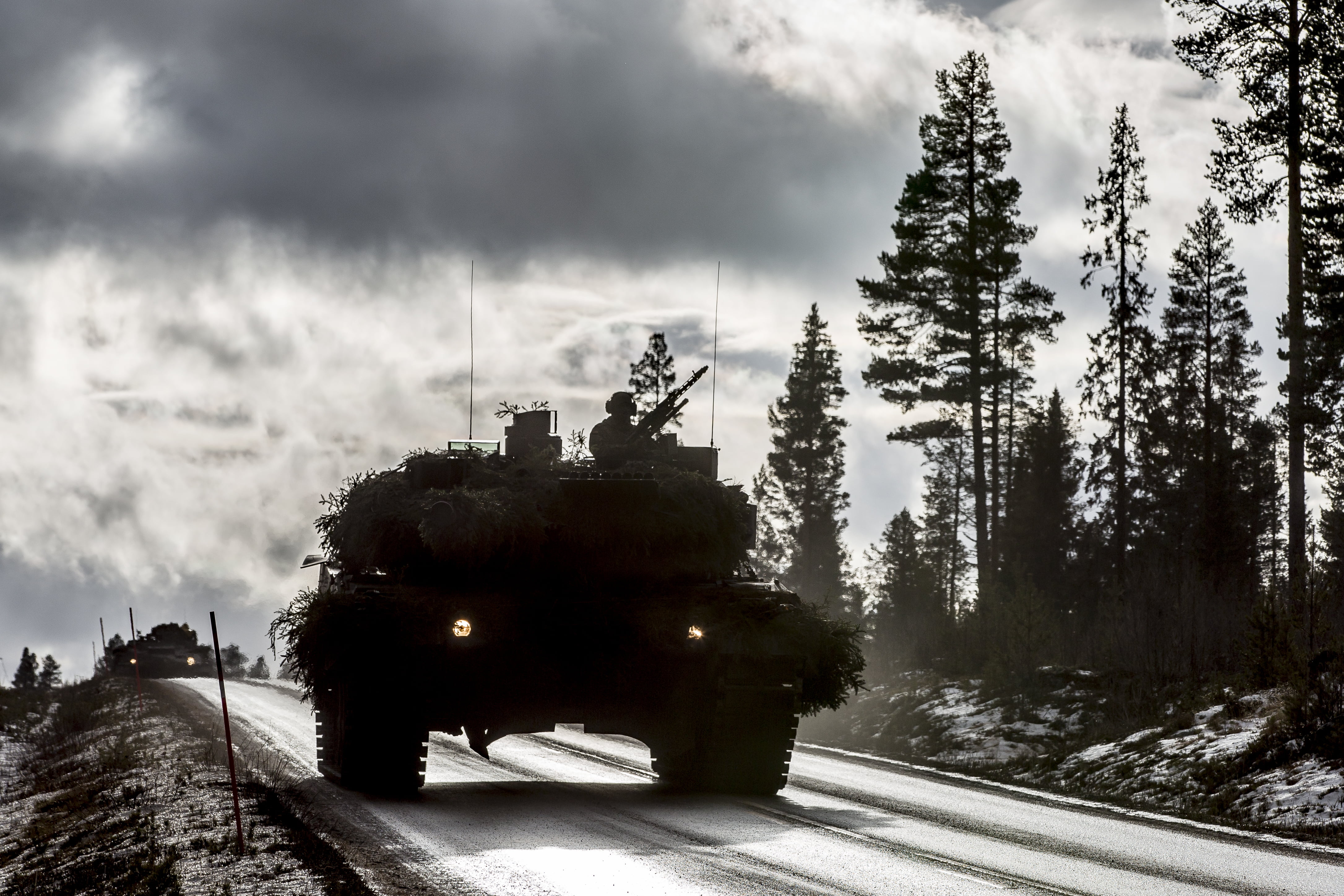By Robbin Laird
During my visit to Germany in February 2019, I had the chance to discuss the return of direct defense in Europe and the way ahead for German defense with an experienced Bundeswehr officer and thinker with many years of NATO experience, Brigadier General (ret.) Rainer Meyer zum Felde.
Meyer zum Felde is currently a Senior Fellow at the Institute for Security Policy Kiel University (ISPK).
From July 2013 to September 2017, he was the Senior Defence Advisor at the Permanent Delegation of Germany to NATO in Brussels and the German Representative in NATO’s Defence Policy and Planning Committee.
Prior to this, he served for two years as Vice President of the Federal Academy for Security Studies in Berlin. He worked in various national assignments related to security policy in the Ministry of Defence, including twice on the Minister’s Policy Planning and Advisory Staff (1996–98; 2006–09) and in the Politico-Military Department (1989–1991).
He has gathered extensive experience at NATO through integrated assignments at both Strategic Command Headquarters in Mons and Norfolk VA, as well as through national assignments at NATO HQ in Brussels, at military as well as political level.
Brigadier General Meyer zum Felde studied educational science at the University of the Bundeswehr in Munich (1974–1977) and holds an MA equivalent (1996) in Security Policy and International Relations from the University of Geneva and the Geneva Centre for Security Policy (GCSP).

Question: How would you characterize the strategic shift in Europe after the Russian actions in Crimea?
Meyer zum Felde: After unification, the basic belief was that friends surrounded us. We wrote in the 2006 White Book, that we did not face a direct threat from Russian anymore and that only the most likely missions, i.e. crisis prevention, crisis response and peace enforcement mission such as in the Balkans and Afghanistan should guide the German defense posture.
“But the Russian aggression against Ukraine, which hit Germany and many other Europeans as a strategic surprise, made clear that this was a wrong assessment. Russia is back as a threat to Europe in the short and mid term.
“And what we have to be concerned about in the long run is an emerging axis between Russia and China, ganging up on a global scale against the West or what then may be left from the “West.”
“Now we face the challenge to rebuild and reconstitute our armed forces at the high end.
“But different from our Eastern European neighbors, who very clearly see themselves threatened by Russian behavior and power, we need to do so in a social context where many Germans do not share the assessment of the NATO governments that Russia poses a direct threat to Europe.
“Unfortunately, even within the coalition government, the consensus on our future defence posture broke during the federal election campaign in summer 2017 and this has not yet been fixed due to purely domestic tactical party politics.”
Question: You have had several tours of duty within NATO and during your time there you were part of the rethink and refocus on the need for higher end forces.
How would you describe that reawakening?
Meyer zum Felde: In 2013 it was increasingly clear that after a 20-year long set of missions at the lower or mid-level COIN and crisis management operations, NATO had lost core skills to provide NATO with the necessary set of forces and capability for high-intensity warfare.
“Although we still talked about the need for sustained collective defense from the mid-1990s on, we failed to underpin direct defense with usable capabilities, larger combat formations and a realistic defense planning process.
“Most European nations decreased their level of readiness, eliminated forces which they believed they no longer needed, notably heavy ones, and turned their forces the kind of expeditionary forces recommended and requested by the Americans and the Brits.
“We certainly followed suit in Germany.
“And the last two decades we no longer prioritized the forces for high-intensity warfare.
“Instead, we used the German armed forces formations since the mid-1990s as a pool for generating contingents for sustained crisis management operations abroad, while shrinking the entire posture to a much lower size and decreasing the defense budget from about 3% to 1.2% of GDP.”
Question: How do you see the way ahead?
Meyer zum Felde: The Germans need to continue to engage with our forces in crisis management missions at the southern periphery of Europe.
“That doesn’t come to an end; but the context has changed.
“Priority must now be again on collective defence and related high intensity warfighting capabilities for credible deterrence.
“The Bundeswehr must become again essential part of the conventional backbone of defence in Europe, similar to its role in the Cold War.
“NATO has significantly changed since 2014 as there has been a clear focus on preparing NATO to deny Russia the option to conduct a hybrid invasion of allied territory or win a regional war in Northeast or Southeast Europe.
“We have accelerated the political and military decision making processes by introducing Graduated Response Plans which more similar to the former General Defence Plan of the Cold War era than to the insufficient recent contingency plans.
“We sharply increased NATO’s responsiveness by tripling the NATO Response Force to a division-sized joint task force of 40.000, with a “spearhead brigade” (called VJTF) in very high readiness.
“These forces are nearly purely European, and complemented by the very impressive return of a full-fletched heavy US division to Europe in the context of the U.S. European Reassurance Initiative.
“Last not least, we promised at Wales in 2014, and have iterated this pledge at every Leader’ Meeting since then, to stop the decline of budgets and move towards the 2 Percent target within a decade, including investing 20% on modern equipment.
“All that is being done in order to prepare NATO better to react in a credible way and more effectively reassuring the eastern member states that are all threatened deeply by Russia and had the feeling they were the next after Crimea and have requested NATO as an alliance to protect them.
“The package produced at the Wales NATO Summit in 2014 from my perspective was reasonable, was meaningful, was balanced, and first what needed to be done.
“General Breedlove, the SACEUR at the time, underscored the central significance for NATO to maintain unity and resolve. Resolve meant to agree upon a really meaningful package of forces with sufficient capability to send a message to reassurance allies and to deter Putin.”
Question: Obviously, you were engaged as a German representative in NATO in these various efforts, what have been the major German foci during this refocusing effort?
Meyer zum Felde: We took a very constructive approach to keep the Alliance together. On the one hand, Germany has emphasized the need to have a two track approach like we did during the Cold War, namely enhancing deterrence but keeping open lines for dialogue with Russia.
“On the other hand, the Germans accepted an increased responsibility for protecting and supporting the allies in our neighborhood. Notably with regard to the Baltics we have deployed an armored battalion to the region, as core of a the multinational battle group in Lithuania under German lead as framework nation. The Brits took care for Estonia, the Canadians for Latvia. All these battlegroups are similar in size and function to the American, British and French Berlin brigades in the time of the Cold War.
“But to be credible these enhanced forward presence battlegroups need to be reinforced and that was the rope of the enhanced NATO response force. Currently for 2019, Germany is providing for the second time after 2015 the brigade sized “spearhead force” (VJTF Land), and given the current state of the German armed forces this is a challenge. The force was trained and certified during the Trident Juncture 2018 exercise and now provides NATO’s first response force in case of need.
“With a view on further reinforcements, we are committed to provide one brigade after the other in the years to come to be able to form two combat divisions with six combat brigades and by the early 2030s, a third division with another two brigades.
“This cannot be done overnight.
“It requires time to reconstitute forces as combat formations, but it is in the plans and under implementation.
“From my perspective, one challenge to winning the debate in Germany for commitments to the kind of deterrent force we need has been President Trump’s position taken during the campaign claiming that NATO is not really relevant but obsolete.
“His calling into question of Article V puts at risks what we have so successfully achieved at the NATO summits in Wales and Warsaw: to maintain unity and resolve as the West’s centre of gravity which is under attack by Russia.
“However, he is right in urging the European governments, in particular Berlin, to fully implement the 2% pledge.
“Here he has a valid point, shared by a broad majority of allies.
“For Germany, it is only through a strengthened NATO that such a commitment will happen.
“Or put another way, to demand that Germany doubles its defense spending, will not happen without reinforcing the notion that NATO matters.
“And what matters most for German defense experts is what Germany cannot substitute on their own, namely a credible nuclear umbrella for Europe.
“It would have far reaching geopolitical consequences, if we could not longer count on the US extended deterrence.
“In that case, being a non-nuclear ally, we would have to reconsider much of what we have agreed and implemented so far.
“If the West failed to maintain its unity and resolve, the only winner of such a development would be Russian and China.”
The featured photo shows an armored platoon of the German Battlegroup of the Very High Readiness Joint Task Force Brigade attacking with main battle tank Leopard 2 from the Norwegian city of Engerdal towards Drevsjo. NATO exercise Trident Juncture, in Norway, at November 04, 2018.
Photo: SGM Marco Dorow, German Army.


